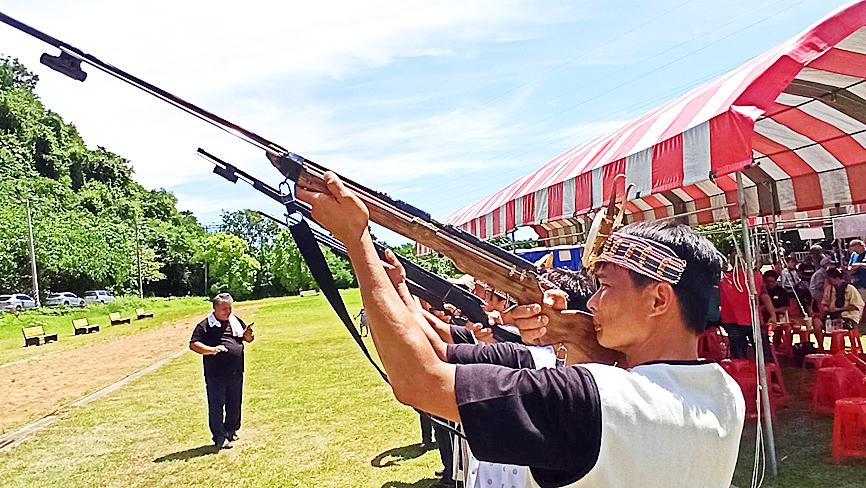Sioulin Township’s (秀林) Truku People’s Hunting Association yesterday awarded 294 hunter certificates to Aborigines of Hualien County, a first step toward self-managed hunting by local Aboriginal villages.
The event might bolster Aborigines’ appeal to the central government to allow more villages to participate in non-commercial hunting, the association said.
After a 2017 project run by the Forestry Bureau’s Hualien Forest District Office helped hunting groups from Tongmen Village (銅門), the groups — from nine townships and 16 villages in Sioulin Township — banded together to form the association.

Photo: Wang Chin-yi, Taipei Times
Yesterday, after overseeing a traditional ceremony of village representatives firing their rifles into the air and lighting smoke bombs, Wenlan Village (文蘭) elder Lowsi Rakaw and association director-general Teyra Yudaw handed out the certificates.
The association follows traditional hunting rules, passes on hunting skills and experience to the next generation, and works with academics and government officials on the sustainability of the natural environment, Yudaw said.
The association’s certificate entails a 20-hour course on topics such as hunting culture, hunter safety, and laws governing hunting and outdoor tracking.
“Our hunters will monitor animal species and regularly patrol the mountains, and we hope to expand our operations into Taroko National Park,” Yudaw said.
Sioulin Township said that it would work with a team led by National Pingtung University of Science and Technology professor Pei Jai-chyi (裴家騏) to set up infrared monitoring and a notation system to record the game hunted by the groups.
District office head Yang Jui-fen (楊瑞芬) said that it would continue to work with the association, and ensure that the nation’s forests and mountains are conserved.
The self-discipline of the Tongmen Village hunting bands has been a key factor in the project’s success and its eventual adoption across Sioulin Township, said National Dong Hwa University environmental studies professor Tai Hsing-sheng (戴興盛), who has been involved in the project for many years.
The event was important for the association and the Truku community, Sioulin Township Mayor Wang Mei-kuei (王玫瑰) said, adding that the township aimed to have Aborigines assist in managing the land.
The Truku community continues to live by their ancestors’ teaching that the “land is our blood, and the mountains and woods our home,” Yudaw said. “We hope to apply conservation methods based on traditional teachings to Taroko National Park and show that the Truku community is once again truly autonomous.”
Yudaw called on the government to honor its pledge of transitional justice for Aborigines and to approve the association’s request that they be allowed to conduct non-commercial hunting on national park land.
“Our ancestors have all hailed from the local mountains and the area is full of materials needed to pass on our cultural,” Yudaw said, lamenting that government policy and environmental protection groups are blocking the Truku community from practicing their culture on traditional land.
“Instead of calling the Taroko National Park a ‘world-renowned scenic hotspot,’ it should instead be known as a large cultural graveyard,” he said.
The knowledge and memories of the Truku community are ebbing away as elders age, Yudaw said, adding that the culture must be passed down so that the community can live how its ancestors lived and believe in Gaya, the teachings and laws set down by the ancestors.

Taiwan is to commence mass production of the Tien Kung (天弓, “Sky Bow”) III, IV and V missiles by the second quarter of this year if the legislature approves the government’s NT$1.25 trillion (US$39.78 billion) special defense budget, an official said yesterday. Commenting on condition of anonymity, a defense official with knowledge of the matter said that the advanced systems are expected to provide crucial capabilities against ballistic and cruise missiles for the proposed “T-Dome,” an advanced, multi-layered air defense network. The Tien Kung III is an air defense missile with a maximum interception altitude of 35km. The Tien Kung IV and V

The disruption of 941 flights in and out of Taiwan due to China’s large-scale military exercises was no accident, but rather the result of a “quasi-blockade” used to simulate creating the air and sea routes needed for an amphibious landing, a military expert said. The disruptions occurred on Tuesday and lasted about 10 hours as China conducted live-fire drills in the Taiwan Strait. The Civil Aviation Administration (CAA) said the exercises affected 857 international flights and 84 domestic flights, affecting more than 100,000 travelers. Su Tzu-yun (蘇紫雲), a research fellow at the government-sponsored Institute for National Defense and Security Research, said the air

Taiwan lacks effective and cost-efficient armaments to intercept rockets, making the planned “T-Dome” interception system necessary, two experts said on Tuesday. The concerns were raised after China’s military fired two waves of rockets during live-fire drills around Taiwan on Tuesday, part of two-day exercises code-named “Justice Mission 2025.” The first wave involved 17 rockets launched at 9am from Pingtan in China’s Fujian Province, according to Lieutenant General Hsieh Jih-sheng (謝日升) of the Office of the Deputy Chief of the General Staff for Intelligence at the Ministry of National Defense. Those rockets landed 70 nautical miles (129.6km) northeast of Keelung without flying over Taiwan,

A strong continental cold air mass is to bring pollutants to Taiwan from tomorrow, the Ministry of Environment said today, as it issued an “orange” air quality alert for most of the country. All of Taiwan except for Hualien and Taitung counties is to be under an “orange” air quality alert tomorrow, indicating air quality that is unhealthy for sensitive groups. In China, areas from Shandong to Shanghai have been enveloped in haze since Saturday, the ministry said in a news release. Yesterday, hourly concentrations of PM2.5 in these areas ranged from 65 to 160 micrograms per cubic meter (mg/m³), and pollutants were